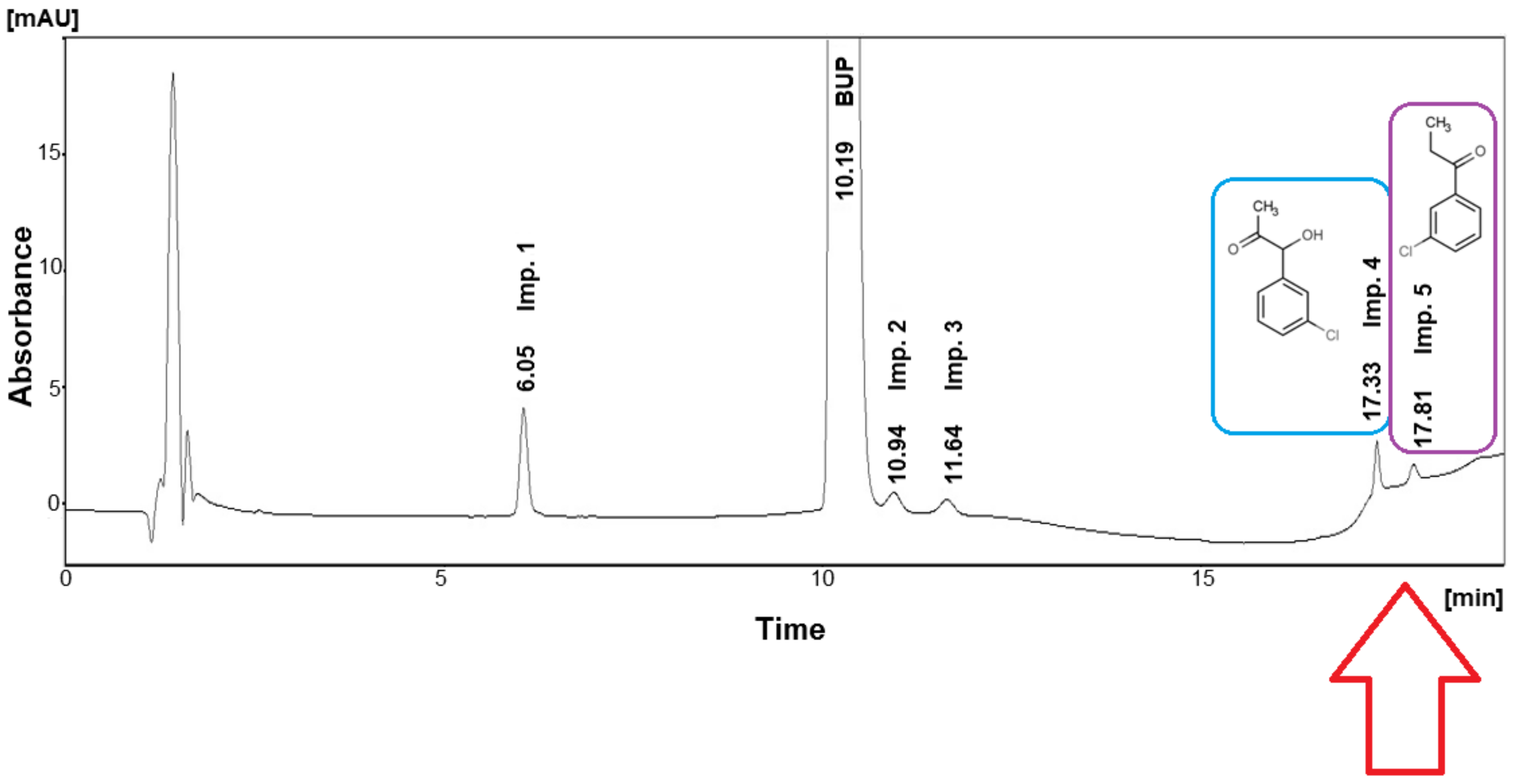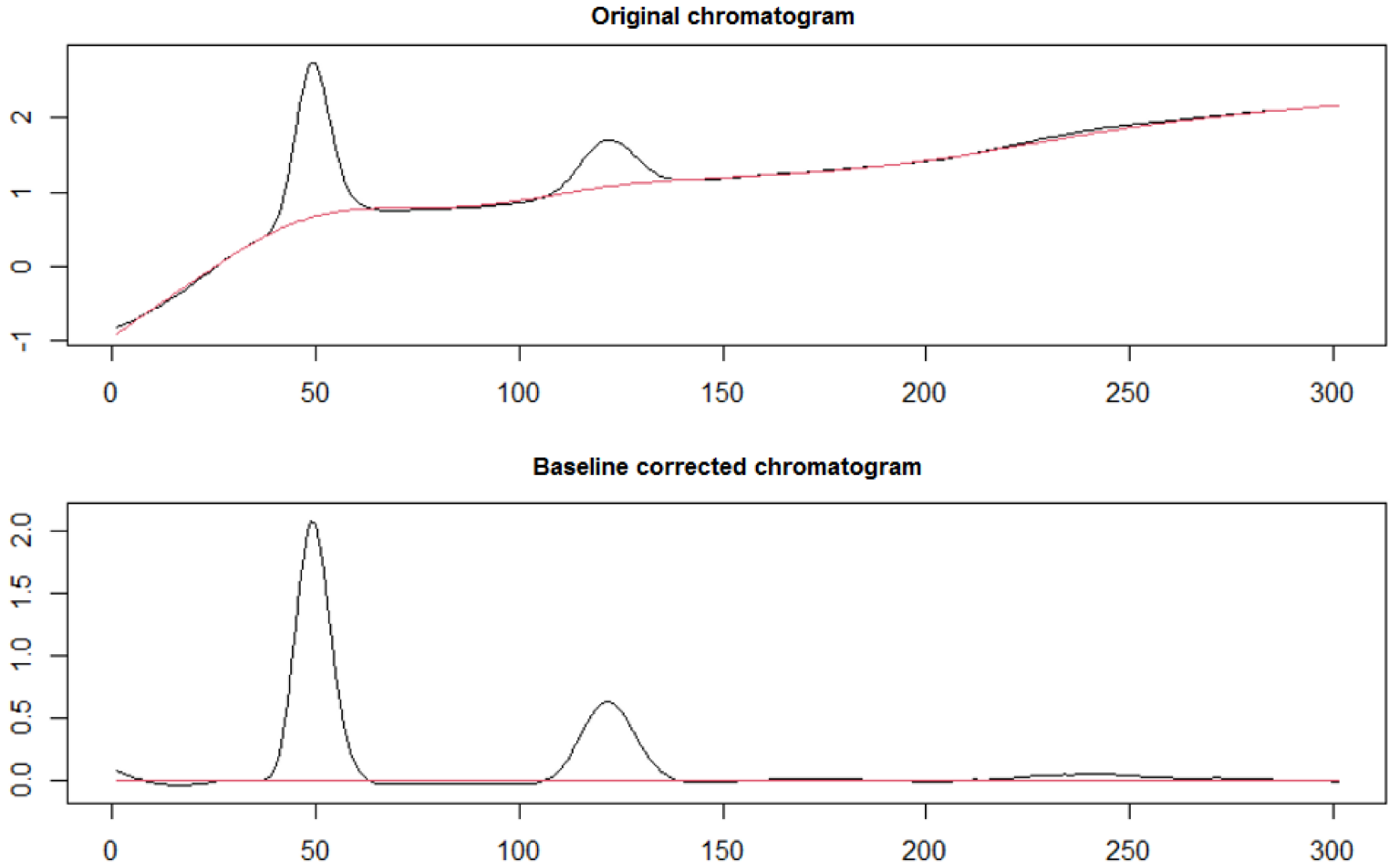Baseline Correction for HPLC Chromatograms by Using Free Open-Source Software
Abstract
:1. Introduction
2. Materials and Methods
2.1. Dataset
2.2. Software
3. Results and Discussion
3.1. Baseline Correction
3.2. Peak Fitting and Integration
3.3. Method Validation
3.4. Robustness Testing
4. Conclusions
Supplementary Materials
Author Contributions
Funding
Institutional Review Board Statement
Informed Consent Statement
Data Availability Statement
Conflicts of Interest
References
- Peng, J.; Peng, S.; Jiang, A.; Wei, J.; Li, C.; Tan, J. Asymmetric least squares for multiple spectra baseline correction. Anal. Chim. Acta 2010, 683, 63–68. [Google Scholar] [CrossRef] [PubMed]
- Gkountanas, K.; Malenovic, A.; Dotsikas, Y. Determination of Bupropion and Its Impurities via a Chaotropic Chromatography Method Following Analytical Quality-by- Design Principles for Method Development. Pharmaceuticals 2022, 15, 1196. [Google Scholar] [CrossRef] [PubMed]
- Gan, F.; Ruan, G.; Mo, J. Baseline correction by improved iterative polynomial fitting with automatic threshold. Chemom. Intell. Lab. Syst. 2006, 82, 59–65. [Google Scholar] [CrossRef]
- Shao, L.; Griffiths, P.R. Automatic baseline correction by wavelet transform for quantitative open-path fourier transform infrared spectroscopy. Environ. Sci. Technol. 2007, 41, 7054–7059. [Google Scholar] [CrossRef] [PubMed]
- Boelens, H.F.M.; Dijkstra, R.J.; Eilers, P.H.C.; Fitzpatrick, F.; Westerhuis, J.A. New background correction method for liquid chromatography with diode array detection, infrared spectroscopic detection and Raman spectroscopic detection. J. Chromatogr. A 2004, 1057, 21–30. [Google Scholar] [CrossRef] [PubMed]
- Cheung, W.; Xu, Y.; Thomas, C.L.P.; Goodacre, R. Discrimination of bacteria using pyrolysis-gas chromatography-differential mobility spectrometry (Py-GC-DMS) and chemometrics. Analyst 2009, 134, 557–563. [Google Scholar] [CrossRef] [PubMed]
- Shen, X.; Xu, L.; Ye, S.; Hu, R.; Jin, L.; Hu, H.; Liu, W. Automatic baseline correction method for the open-path Fourier transform infrared spectra by using simple iterative averaging. Opt. Express 2018, 26, A609–A614. [Google Scholar] [CrossRef] [PubMed]
- Cai, Y.; Yang, C.; Xu, D.; Gui, W. Baseline correction for Raman spectra using penalized spline smoothing based on vector transformation. Anal. Methods 2018, 10, 3525–3533. [Google Scholar] [CrossRef]
- Dagla, I.; Tsarbopoulos, A.; Gikas, E. A novel validated injectable colistimethate sodium analysis combining advanced chemometrics and design of experiments. Molecules 2021, 26, 1546. [Google Scholar] [CrossRef] [PubMed]
- Rstudio. Available online: https://posit.co/ (accessed on 2 December 2022).
- Fityk. Available online: https://fityk.nieto.pl/ (accessed on 2 December 2022).
- Crowther, J.B. Validation of pharmaceutical test methods. In Handbook of Modern Pharmaceutical Analysis; Ahuja, S., Scypinski, S., Eds.; Academic Press: New York, NY, USA, 2001; pp. 415–443. [Google Scholar]
- Kallinteris, K.; Gkountanas, K.; Karamitros, I.; Boutsikaris, H.; Dotsikas, Y. Development and Validation of a Novel HPLC Method for the Determination of Ephedrine Hydrochloride in Nasal Ointment. Separations 2022, 9, 198. [Google Scholar] [CrossRef]
- Vrachas, A.; Gkountanas, K.; Boutsikaris, H.; Dotsikas, Y. Development and Validation of a Novel RP-HPLC Method for the Determination of Cetrimide and Chlorhexidine Gluconate in Antiseptic Solution. Analytica 2022, 3, 79–91. [Google Scholar] [CrossRef]
- Neofotistos, A.-D.; Gkountanas, K.; Boutsikaris, H.; Dotsikas, Y. A Validated RP-HPLC Method for the Determination of Butamirate Citrate and Benzoic Acid in Syrup, Based on an Experimental Design Assessment of Robustness. Separations 2021, 8, 163. [Google Scholar] [CrossRef]





| Compound | Linearity | Accuracy (Precision) | |||||
|---|---|---|---|---|---|---|---|
| Method | Concentration Range (μg/mL) | a | b | r | Concentration Level (μg/mL) | % Recovery (% RSD) * | |
| Imp. 4 | Manualintegration | 1.8–12 | 0.847 | −0.458 | 0.9967 | 1.8 (LOQ) 9.0 (100%) 12 (120%) | 99.7 (2.4) 102.1 (1.5) 99.3 (4.6) |
| Baselinecorrection | 0.0132 | 0.0131 | 0.9968 | 1.8 (LOQ) 9.0 (100%) 12 (120%) | 91.7 (5.4) 107.4 (1.8) 93.4 (0.6) | ||
| Imp. 5 | Automaticintegration | 0.2–0.8 | 10.511 | −0.0792 | 0.9993 | 0.2 (LOQ) 0.4 (100%) 0.8 (120%) | 102.8 (2.9) 103.4 (0.1) 103.3 (2.4) |
| Baselinecorrection | 0.1701 | −0.0025 | 0.9938 | 0.2 (LOQ) 0.4 (100%) 0.8 (120%) | 85.5 (1.8) 101.6 (0.9) 103.5 (103.5) | ||
| Run | Factors | Responses | |||||
|---|---|---|---|---|---|---|---|
| A | B | C (Min) | AIMP4_LOQ | AIMP5_LOQ | AIMP4_SL | AIMP5_SL | |
| 1 | 4 | 0.05 | 2 | 0.0367 | 0.0323 | 0.1352 | 0.0941 |
| 2 | 4 | 0.05 | 2 | 0.0367 | 0.0323 | 0.1352 | 0.0941 |
| 3 | 3 | 0.06 | 1.5 | 0.0210 | 0.0226 | 0.1078 | 0.0632 |
| 4 | 5 | 0.04 | 1.5 | 0.0594 | 0.0372 | 0.1710 | 0.1016 |
| 5 | 5 | 0.06 | 1.5 | 0.0504 | 0.0355 | 0.1620 | 0.1002 |
| 6 | 3 | 0.04 | 2.5 | 0.0239 | 0.0264 | 0.1125 | 0.0702 |
| 7 | 5 | 0.06 | 2.5 | 0.1126 | 0.0356 | 0.1716 | 0.0999 |
| 8 | 3 | 0.06 | 2.5 | 0.0210 | 0.0226 | 0.1079 | 0.0631 |
| 9 | 3 | 0.04 | 1.5 | 0.0230 | 0.0264 | 0.1125 | 0.0702 |
| 10 | 4 | 0.05 | 2 | 0.0367 | 0.0323 | 0.1352 | 0.0941 |
| 11 | 5 | 0.04 | 2.5 | 0.1650 | 0.0387 | 0.17563 | 0.1014 |
Disclaimer/Publisher’s Note: The statements, opinions and data contained in all publications are solely those of the individual author(s) and contributor(s) and not of MDPI and/or the editor(s). MDPI and/or the editor(s) disclaim responsibility for any injury to people or property resulting from any ideas, methods, instructions or products referred to in the content. |
© 2023 by the authors. Licensee MDPI, Basel, Switzerland. This article is an open access article distributed under the terms and conditions of the Creative Commons Attribution (CC BY) license (https://creativecommons.org/licenses/by/4.0/).
Share and Cite
Gkountanas, K.; Dagla, I.; Gikas, E.; Malenović, A.; Dotsikas, Y. Baseline Correction for HPLC Chromatograms by Using Free Open-Source Software. Analytica 2023, 4, 45-53. https://doi.org/10.3390/analytica4010005
Gkountanas K, Dagla I, Gikas E, Malenović A, Dotsikas Y. Baseline Correction for HPLC Chromatograms by Using Free Open-Source Software. Analytica. 2023; 4(1):45-53. https://doi.org/10.3390/analytica4010005
Chicago/Turabian StyleGkountanas, Kostas, Ioanna Dagla, Evangelos Gikas, Anđelija Malenović, and Yannis Dotsikas. 2023. "Baseline Correction for HPLC Chromatograms by Using Free Open-Source Software" Analytica 4, no. 1: 45-53. https://doi.org/10.3390/analytica4010005
APA StyleGkountanas, K., Dagla, I., Gikas, E., Malenović, A., & Dotsikas, Y. (2023). Baseline Correction for HPLC Chromatograms by Using Free Open-Source Software. Analytica, 4(1), 45-53. https://doi.org/10.3390/analytica4010005











